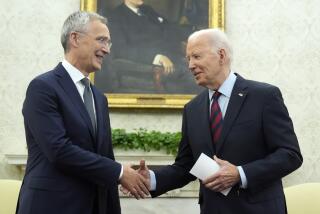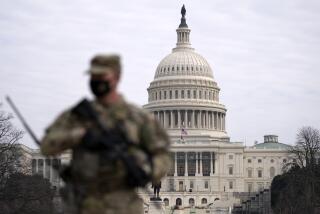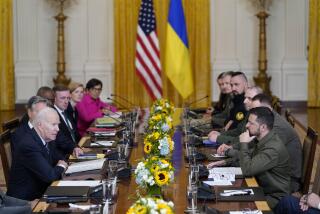Canada Defense Spending Called Low
TORONTO â Canada should dramatically boost its military budget, ruling and opposition lawmakers said in a report released Thursday, agreeing with calls from the U.S. and other NATO members for a greater Canadian commitment to the alliance.
The report said Canada needs another $3 billion to upgrade its aging helicopter fleet, and should increase overall military spending to 1.5% of gross domestic product, up from 1.1%--the second-lowest level in the North Atlantic Treaty Organization.
âIt would allow us to hold our heads a little higher around the NATO table, by not being next to Luxembourg in defense spending,â said David Pratt, a Liberal Party member and chairman of the House of Commons Defense Committee, which released the report in Ottawa.
The report said spending on Canadaâs armed forces has dropped in real terms by almost a third since 1988, and it recommended a steep and swift correction: a 50% jump over three years, reaching the goal of 1.5% of GDP by 2006. This would raise the military budget to approximately $12 billion--tiny by American standards but a substantial investment for Canadaâs much smaller economy.
Still, as committee members noted Thursday, this would put Canada at only about the median defense-spending level for NATO countries.
George Robertson, the allianceâs secretary-general, has called on Canada and other lower spenders to increase their commitments to the collective defense pact, a request echoed by Pentagon officials and members of the U.S. Congress.
The strongly worded Canadian report marks an unusual display of unanimity in the normally fractious Parliament. The findings were backed not only by the governing Liberals on the committee, but by representatives of the leftist New Democrats and right-wing Canadian Alliance and Progressive Conservative parties. The only dissenters were the Bloc Quebecois, which has long opposed big defense outlays.
âIt is hard to get government MPs [members of Parliament] to sign on to a report calling for such difficult and substantive matters, and I give them credit for doing that,â said Leon Benoit, a committee member and chief spokesman for the Canadian Alliance on defense issues.
But Prime Minister Jean Chretien must still weigh the proposal, and his initial reaction was curtly skeptical.
âEveryone would like us to spend more money,â he told reporters outside Parliament on Thursday, noting demands this week for aid to Canadian farmers who say they will be hurt by subsidies recently approved for their U.S. competitors. There also were calls for Parliament to fund more foreign assistance, with the New Democrats noting that the Chretien government has devoted progressively less of its budget to overseas aid grants.
âWe have provided a big increase in the budget for defense over the past few years, and we will increase it next year too,â Chretien said, without specifying amounts.
By opposition accounting, though, a hike in military spending since Sept. 11 represented the first real increase in core defense appropriations since Chretien took office nine years ago. The government also has provided more funds for intelligence agencies and border security since last fall.
Some defense experts questioned the committeeâs call for a revival of Canadaâs moribund naval shipyards, a proposal several members embraced Thursday as a job-creation program for economically depressed Nova Scotia and Newfoundland.
But the new pan-ideological consensus that Canada needs to expand and modernize its armed forces is a reflection of the changed climate here since Sept. 11, which precipitated the first overseas commitment of Canadian combat troops since the Korean War.
âIt is important that the Canadian military maintains combat-capable forces ready to join coalitions and make a meaningful contribution,â the committee report said.
With the Pentagon proposing closer coordination with Canadian forces under a newly organized North American command, critics here have voiced concerns that overwhelming U.S. superiority in technology and troop strength could preclude genuine collaboration.
âAre we going to be ready for our dominant partner and ally?â Desmond Morton, a prominent Canadian military analyst, asked Thursday. âThatâs the real issue here, not self-defense.â
The parliamentary report comes at a time of turmoil in the upper echelons of Canadaâs Defense Ministry, making a swift response more difficult. Art Eggleton, Chretienâs longtime defense minister, resigned Sunday for an ethical breach only tangentially related to military affairs; he gave a former girlfriend a $24,000 contract for a 14-page report on the physical and mental health impact of combat service.
But Eggleton had come under fire earlier this month when he announced that Canada was withdrawing 800 elite infantry troops from Afghanistan because the armed forces were âstretched too thin.â He acknowledged that the Pentagon asked Canada to keep the battalion in place, but said U.S. commanders âunderstood that we couldnât stay, that we needed time to rest and regroup.â
Canada is keeping another 1,300 naval and air force personnel in and around Afghanistan as part of the coalition. The countryâs biggest overseas military commitment is to the U.N. force in Bosnia-Herzegovina, where it has 1,700 soldiers.
Some legislators have said Canadian forces should reduce their engagement in international peacekeeping operations and rebuild more traditional combat capabilities. However, the Commons committee argues that Canada could and should do both--provided that the government appropriates the needed resources.
âOur foreign policy has been writing checks that our defense policy canât cash,â said Pratt, the committee chairman.
John McCallum, a novice legislator unexpectedly named to replace Eggleton, said that he is far from mastering his new portfolio and declined to comment on the report.
âI will read it attentively, and at the appropriate time I will respond,â he said.
More to Read
Sign up for Essential California
The most important California stories and recommendations in your inbox every morning.
You may occasionally receive promotional content from the Los Angeles Times.










